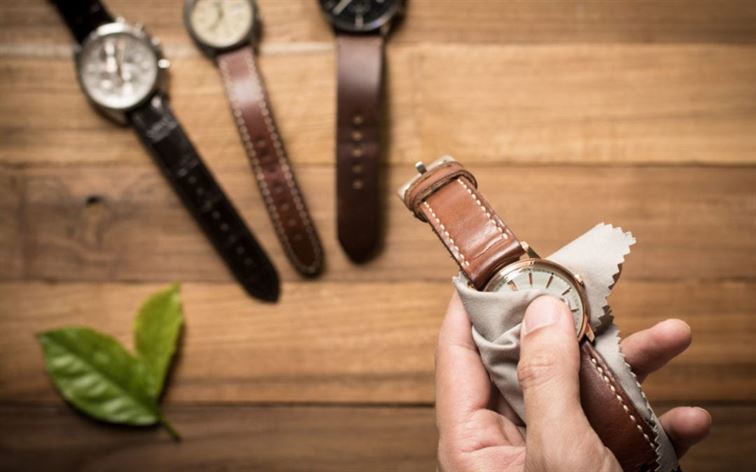Your cart is currently empty.
Go To Shop
Owning a vintage luxury watch brings with it one very important responsibility – the cleaning of that timepiece. The common rule of thumb is to clean your collectible watch weekly with a soft cloth. Bear in mind that by following a routine of cleaning and maintenance of your rare watch, it will not only look pristine but will continue to operate efficiently.
How To Clean The Watch Face
First, fill a dish with a mixture of warm water and a little bit of a mild detergent. Dip either a soft-bristled toothbrush or soft chamois cloth into the liquid and brush gently over the surface of the watch face. Avoid applying too much pressure or brushing vigorously as you are only interested in collecting the loose dirt and debris that is on the watch face. If there are marks or crystals on the watch face, use a Q-tip dipped into your soapy water solution and gently work around the watch face. If you happen to own a vintage watch, you should not clean it yourself. Older watches contain radium and a specialty jewelry store will have the proper tools to clean your collectible watch correctly. Also, do not remove the watch face to clean the dial. The watch dial will not get dirty as it is protected by the watch’s face.
Do Not Get Your Luxury Watch Wet
The construction of vintage watches differs from that of today’s contemporary watches. Early timepieces were not made to be waterproof as it was common to remove your watch before getting wet. Because collectible watches contain gaskets, which may dry out, moisture may seep inside and fog up the crystal. Although that will disappear over time, keeping your vintage watch away from water will prevent it from happening. For the newer watches that are made to be worn underwater, bear in mind that salt water and chlorine can be corrosive, and sweating while wearing a watch playing sports may also increase the possibility of moisture damage. Always wipe your luxury watch clean with a damp cloth after any of these activities.

The Watch Band
The method you use to clean your rare watch band depends entirely on the material it is made from. The most common types of watch bands are leather, stainless steel, nylon, and rubber. Before cleaning any watch band it is a good idea to remove it from the
watch. This permits you to wipe them down without the possibility of causing damage to the watch face.
Leather Watch Bands
There are several different types of leather watch bands. They include cowhide, ostrich, and crocodile and each should be wiped down with a damp cloth. If the watch band is very dirty or has an odor, add a dab of hand soap to the damp cloth. Before you reattach the watch, gently dry and buff the watch band with a clean cloth. Because leather bands react to moisture and perspiration, remove your watch before any form of exercise and wipe the band daily with a dry cloth.
Metal Watch Bands
Metal watch bands including stainless steel, silver, gold, and others may rust. Clean these with a soapy water solution applied with a soft-bristled toothbrush. Allow to air dry completely before wearing it again.
Nylon Watch Bands
These are very likely the easiest of the watch bands to clean. Once you remove it from your watch, place in a mesh laundry bag, and toss it into your next load of laundry.
Rubber Watch Bands
Rubber watch bands are much like metal ones only the rubber ones will absorb oils and perspiration. Plus, if they are not cleaned properly, they can develop cracks that will damage the band to where it may break. The best way to keep rubber watch bands clean is to use a warm soapy solution with a soft-bristled toothbrush. Gently clean both sides of the watch band, rinse with clean water, and allow to air dry. Should you wear your rubber watch band in salt water, rinse it off immediately. To keep the band soft and comfortable, use a rubber protectant.
Do Not Use A Screwdriver To Remove Grime
There are times when dirt and grime get stuck to the surface of your vintage watch. While you may consider using a small screwdriver to scrape away at the buildup, you shouldn’t. The metal in the screwdriver can scratch the surface of the watch face. It can also chip away paint from the watch or cause damage to any type of watch strap you have. The safest way to remove stuck dirt or grime from your watch is with a bamboo skewer. Use the sharp, pointed end and work it into the buildup. Not only will you not risk scratching your watch, but the bamboo is also strong enough to permit you to dig into tight spots without damaging your luxury watch.
Keep Watch Movements In Good Working Order
The main part of any watch is the movements. These are the tiny gears and parts that are carefully hidden inside the watch and are responsible for the dial to show you the time, date, and additional information. Depending on the watch, there could be hundreds of individual components tucked away neatly inside your watch. One way to ensure that your watch movements continue to operate smoothly is to take your watch to a qualified jeweler to examine and clean periodically. This is NOT a do-it-yourself project.
Skilled technicians can open the back of your watch and work inside of the movements as they carefully disassemble your collectible watch. As they do this, each part that is removed will be cleaned and lubricated where necessary. Many of these parts are hard to see with the naked eye and require special tools to remove and replace. Once a watch technician has completed the cleaning process, your watch will be reassembled and the timing will be adjusted. This will keep your valuable watch working as efficiently as possible.
Other Things To Watch Out For When Cleaning Your Watch
You may have seen the sales pitch for at-home ultrasonic cleaners. These are commonly used for dentures and other pieces of jewelry. They consist of a basket you place the item you wish to clean and dip it into a cavity filled with water or a cleaning solution. Then ultrasonic waves are sent into the cavity and this provides a deep clean for whatever is resting in the basket. These appliances are effective in some applications but should not be used to clean a vintage watch.
Always Protect Your Rare Collectable Watch
Any type of liquid that could leech through the case of your vintage watch should be avoided. Do not expose your valuable timepiece to perfumes or any greasy substance such as hand cream. If even a little were to end up on the dial of your watch, it could soil it by leaving behind a stain. This would ruin the look you have been taking care of for as
long as you’ve had the watch. Watches manufactured before 1980 are particularly susceptible to this.
In Conclusion
The best way to keep your luxury watch looking good and running well is to take proper care of it. With a regular cleaning that you can do at home to the watch face and band, plus periodic internal cleaning conducted by a qualified watch technician, your watch will keep time and look great doing so from many years to come.

